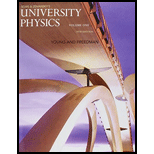
Van der Waals bonds occur in many molecules, but hydrogen bonds occur only with materials that contain hydrogen. Why is this type of bond unique to hydrogen?
Why hydrogen bonds occur only with materials that contain hydrogen.
Answer to Problem 42.1DQ
The hydrogen bonds occur only with materials that contain hydrogen because only hydrogen has a singly ionized state with no remaining electron cloud.
Explanation of Solution
Explanation:
Hydrogen bond is an attraction between hydrogen bound to a more electronegative atom and another adjacent atom having a lone pair of electrons. It is stronger than van der Waals bond while weaker than ionic and covalent bonds.
In hydrogen bond, a proton gets between two atoms, polarizing them and attracting them by means of the induced dipoles. Hydrogen bond is unique to hydrogen containing compounds because only hydrogen has a singly ionized state with no remaining electron cloud. The hydrogen ion is a bare proton, much smaller than any other singly ionized atom.
Conclusion:
Thus the hydrogen bonds occur only with materials that contain hydrogen because only hydrogen has a singly ionized state with no remaining electron cloud.
Want to see more full solutions like this?
Chapter 42 Solutions
University Physics with Modern Physics, Volume 1 (Chs. 1-20) (14th Edition)
Additional Science Textbook Solutions
Microbiology: An Introduction
Genetic Analysis: An Integrated Approach (3rd Edition)
Campbell Biology in Focus (2nd Edition)
Chemistry: An Introduction to General, Organic, and Biological Chemistry (13th Edition)
Introductory Chemistry (6th Edition)
- Help me make a visualize experimental setup using a word document. For the theory below.arrow_forwardHow to solve this, given answerarrow_forwardThree point-like charges are placed at the corners of a square as shown in the figure, 28.0 cm on each side. Find the minimum amount of work required by an external force to move the charge q1 to infinity. Let q1=-2.10 μC, q2=+2.40 μС, q3=+3.60 μC.arrow_forward
- A point charge of -4.00 nC is at the origin, and a second point charge of 6.00 nC is on the x axis at x= 0.820 mm . Find the magnitude and direction of the electric field at each of the following points on the x axis. x2 = 19.0 cmarrow_forwardFour point-like charges are placed as shown in the figure, three of them are at the corners and one at the center of a square, 36.0 cm on each side. What is the electric potential at the empty corner? Let q1=q3=+26.0 µС, q2=-28.0 μC, and q4=-48.0μc Varrow_forwardPLS HELparrow_forward
 Modern PhysicsPhysicsISBN:9781111794378Author:Raymond A. Serway, Clement J. Moses, Curt A. MoyerPublisher:Cengage Learning
Modern PhysicsPhysicsISBN:9781111794378Author:Raymond A. Serway, Clement J. Moses, Curt A. MoyerPublisher:Cengage Learning University Physics Volume 3PhysicsISBN:9781938168185Author:William Moebs, Jeff SannyPublisher:OpenStax
University Physics Volume 3PhysicsISBN:9781938168185Author:William Moebs, Jeff SannyPublisher:OpenStax Physics for Scientists and Engineers with Modern ...PhysicsISBN:9781337553292Author:Raymond A. Serway, John W. JewettPublisher:Cengage Learning
Physics for Scientists and Engineers with Modern ...PhysicsISBN:9781337553292Author:Raymond A. Serway, John W. JewettPublisher:Cengage Learning An Introduction to Physical SciencePhysicsISBN:9781305079137Author:James Shipman, Jerry D. Wilson, Charles A. Higgins, Omar TorresPublisher:Cengage Learning
An Introduction to Physical SciencePhysicsISBN:9781305079137Author:James Shipman, Jerry D. Wilson, Charles A. Higgins, Omar TorresPublisher:Cengage Learning Glencoe Physics: Principles and Problems, Student...PhysicsISBN:9780078807213Author:Paul W. ZitzewitzPublisher:Glencoe/McGraw-Hill
Glencoe Physics: Principles and Problems, Student...PhysicsISBN:9780078807213Author:Paul W. ZitzewitzPublisher:Glencoe/McGraw-Hill





